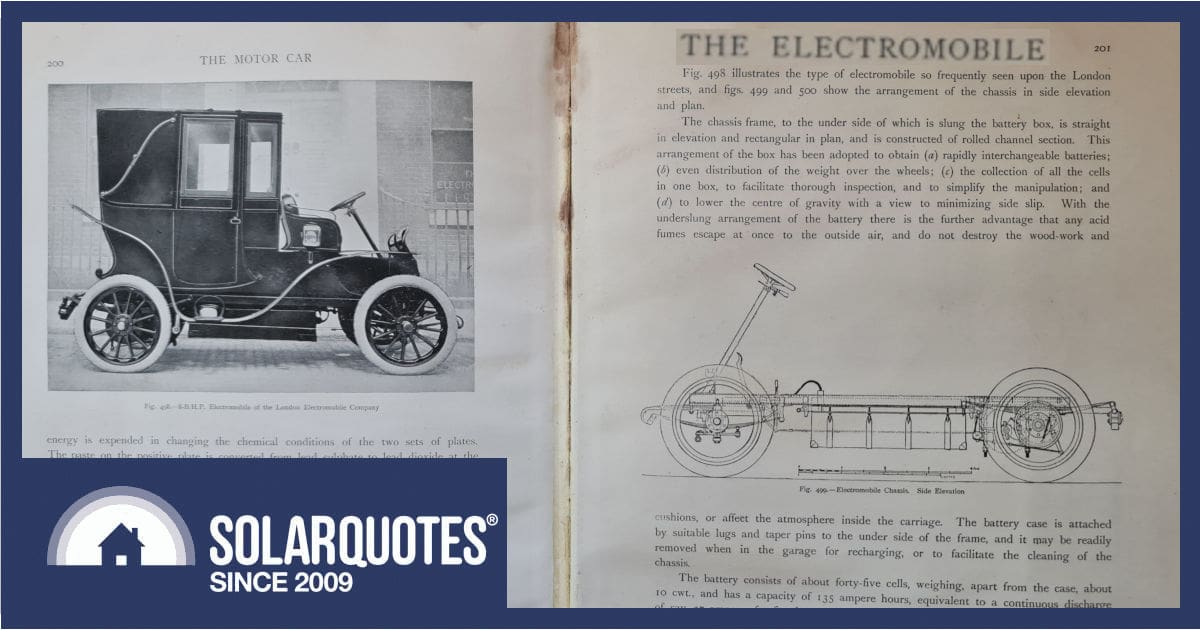
Image credit “Modern Power Generators” printed 1908
The first car I ever owned turns 100 this year.
What tenuous link does this have with solar energy for your home or business? Well, I guess it’s mainly about fuel… and access to it.
Combustion Engines Scared The Horses
As a young bloke, my grandfather ran a team of horses to plough his farm, so a portion of productive ground was set aside for feeding them. As a society, we had vast tracts of land dedicated to growing chaff to fuel the transport network, which was horses.
People living in towns and cities had to buy chaff in, because they couldn’t grow enough at home.
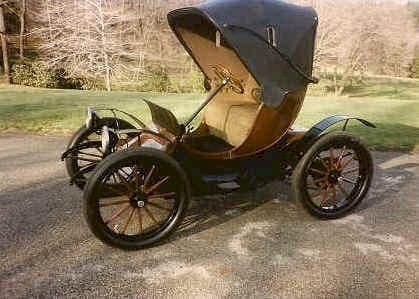
An EV from 1913. This isn’t an automobile, it’s an electromobile.
Around 1900, Steam was the technology with a hundred-year history, EVs were 38% of the market, and infernal combustion engines were unreliable, smelly and frightened the horses. (which was important when the only thing more ubiquitous on the street was horse manure)
Within 13 years, that status quo was utterly upended. Cars had taken over. But people still had to buy their fuel in.
Parallel Innovation, 100 Years Later
How did it happen? Well, Henry Ford happened. Ford built the Model T and created a mass market in the process. I own a few examples, and I could wax on about them… but a few parallels have struck me between the innovation back in the 1900s and the innovation we’re seeing today.
In 1914, Ford was building over 1,000 cars per day. He doubled the working wage and made 25% profit on every car; he developed new methods and machines that put him streets ahead of the competition and made no secret of how.
Tesla, with its open patents, has pushed tool makers to invent a machine that casts the whole front end of a car in seconds — almost as fast as Henry was more than a century ago.
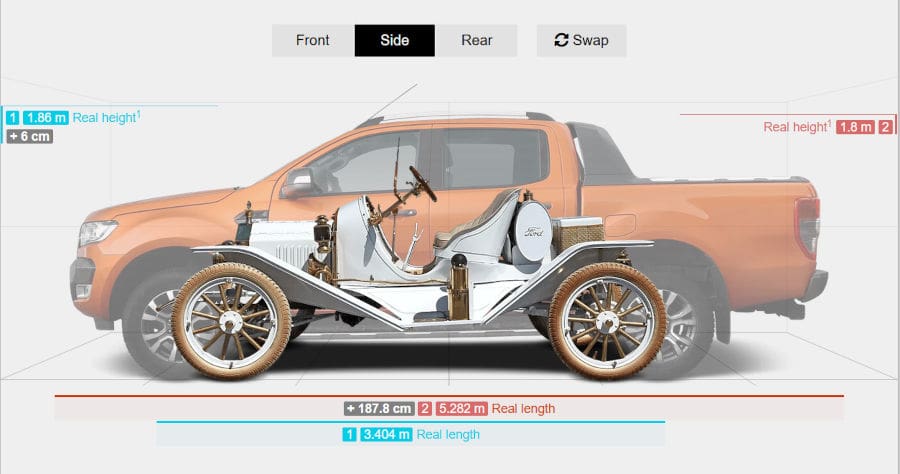
Australia’s most popular vehicles, 100 years apart. The Model T is a pretty racy, low-slung version, if we’re being honest.
Cost Curvature
Ford cut prices for the Model T for 19 years straight. Every year, despite inflation, the price fell.
So when you read about Hertz quitting EVs and going back to petrol, remember that Tesla has cut prices, thus cutting the resale value of a one-year-old rental fleet. Hertz is a used car company as much as anything.
History Is Repeating
Still, by 1930, Doble had steam cars started from cold in a minute, hitting full speed in 90 seconds. However, they were expensive and thirsty and would never approach the price of the then-dominant petrol car. The Steam era was over.
While petrol engines are faster and cleaner than ever, Tesla has opened the door to the newest era. Now we’re seeing cheaper models coming from China, legacy car makers should be petrified.
Apparently it was 21 years ago that DVD players outsold VCRs for the first time. 2 years on they were outselling by 40 to 1. Funai of Japan, the very last manufacturer, ceased production of VHS equipment 8 years ago.
The Model T Is Beautifully, Gorgeously, Supremely, Simple.
The T Ford has a four-cylinder side-valve engine, a two-speed transmission and — after 1919 — fancy electric lights and starting.
With no water pump, fuel pump, oil pump, or front brakes, there is very little to go wrong with the most significant car of all time.
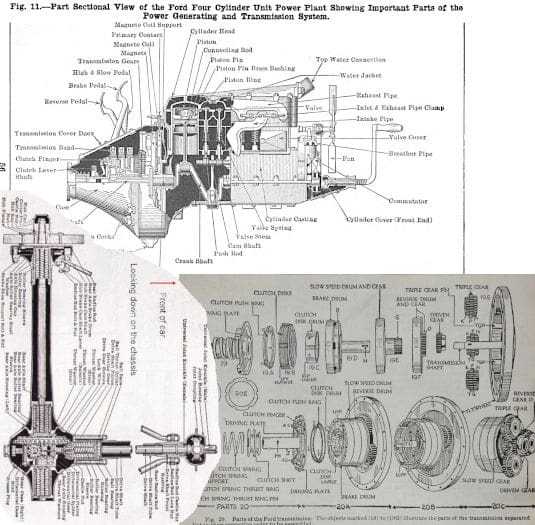
By modern standards this is a simple machine, but not compared to an EV
Here’s the kicker: my modest little EV has far fewer moving parts.
The electric motor in an iMiev has two bearings and one moving part. The motor for a Model T Ford has 25 bearings or bushings and 115+ moving parts, depending on how you count them.
For a very simple combustion engine, there’s a lot of machining involved to get them all to fit and play nicely with three litres of motor oil.
Granted, modern EVs have coolant pumps, air conditioning, electric windows, remote mirrors, central locking and a kilometre or three of complex wiring. But the energy consumption is much more modest than Ford’s 20 miles per gallon.
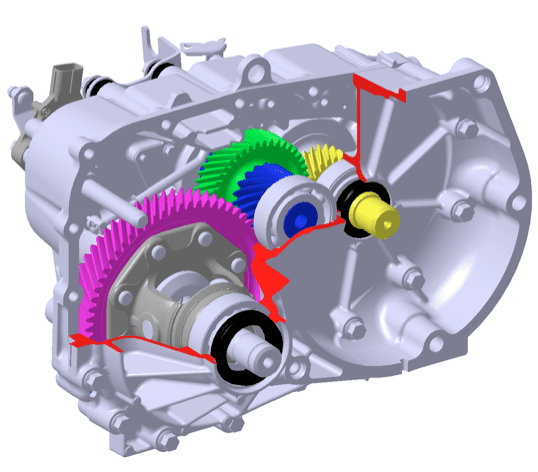
Eight gears and six bearings make up an iMiev transaxle. The rear axle in a T Ford has one less cog and just as many bearings.
Can We Regain The Virtue Of Vehicles Past?
We may need to reject the idea of what has been sold to us as progress.
My twin turbo diesel VW idles at 800 rpm, while a T Ford makes maximum torque for climbing hills at 900 rpm. From an engine that develops just 2ohp at 1600rpm, 55km/h is a comfortable cruising speed. But to flatten hills and go twice as fast, the VW is given 10 times as much power.
The principal difference is weight.
My dual cab, six-speed, all-wheel drive work-wagon weighs three to four times as much as a T Ford.
That’s a hell of a lot to manufacture and to drag around with you everywhere. I should know, because I hoard too many tools and spare parts in my ute.

Commuting with two tonnes of extra weight is a bit ludicrous really
Reject Modernity, Embrace Beauty… And Bicycles
They say simplicity is the ultimate refinement. If you ask me, humanity’s most efficient invention is the bicycle… and we should get back on our bikes.
To this end, some visionary local councils in Adelaide offer incentives for people to buy cargo bikes.
With electric assistance, they become an incredibly practical tool for last-mile goods delivery, grocery getting and child carting. An average speed of 25km/h is enough… all they really need is some civil disobedience on the 250-watt electric power limit.
We already know about improved health outcomes for riders, but the benefits don’t stop there. There are improved societal outcomes, too.
When the streets are ‘clogged’ with separated bicycle lanes instead of parking, governments don’t have to waste money on roundabouts, speed humps, crossings or traffic lights. With less public space surrendered to cars, kids can play outside and people might meet their neighbours, creating more cohesive communities.
Renewables Are Practical Now
If we’re going to get on with an energy transition, we need to get on better with our neighbours. A key component is sharing resources; solar power is a great starting point.
If you’re lucky enough to have a house in the suburbs with enough solar roof space to power your life, you’ll need that energy to run an EV or eBike because suburbs have sprawled, and services are further apart.
If you’re lucky enough to live in a city dense enough to support public transport at seven-minute intervals, then getting around isn’t going to be a problem. But apartment dwelling isn’t ideal for solar self-sufficiency.
Either way, solar is now the cheapest energy ever generated, and — for the first time — it can be generated within the home. Incumbent industries, like domestic gas, they’re the horses we are scaring now.
It’s been pleasing over the past couple of years to see a change in rhetoric as people realise the benefits of renewable power.
For the first time, it’s practical to live in a reasonably built-up area and have an endless supply of energy available. Cheap, safe, reliable, renewable, quiet; what’s not to love about solar energy?
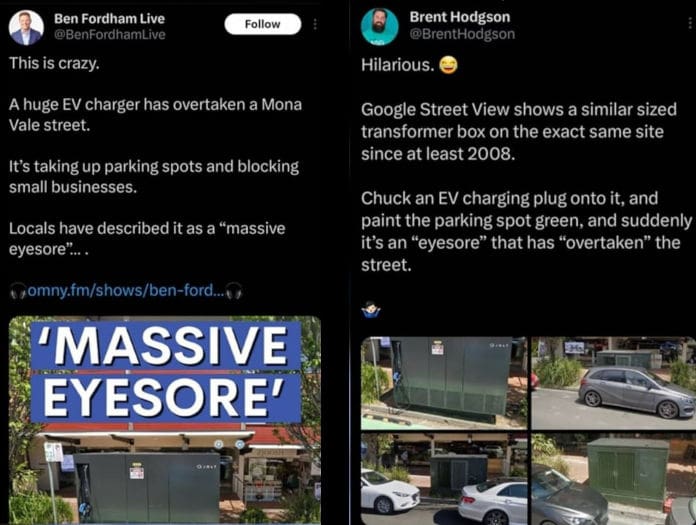
More people are now calling out the sceptics.
Energy Solutions Are Here
We need the political will to remove electricity networks from private monopolies and focus on making them a public good.
We can share electricity when it’s abundant, store it when it’s scarce, and reduce costs for everyone.
If that sounds like some mad experiment or a communist utopia that will never work, then please tune in next week when we’ll explain the retail model that’s already in place to make it happen.

 RSS - Posts
RSS - Posts



Lovely piece. Combustion engines are rubbish technology, always have been and always will be. (I say that as an engineer.) Inefficient, noisy, filthy, far too many complex moving parts.
The one factor you didn’t mention which gave them a victory over early electromobiles was the cheap oil Rockefeller flooded the world with. That was the real accelerant.
Well that escalated quickly
I was expecting something about EVs taking over the World and suddenly better ‘solutions’ were on the menu.
Of course you are spot on. If we are serious about getting emissions down fast, Cybertrucks aren’t the answer. eBikes are fantastic and enable most humans to move quickly and efficiently. Paired with efficient Public Transport, we could slash our transport emissions virtually overnight.
You are also correct about networks however they are a cash cow the owners are unwilling to give up cheaply.
Well you’ve already mentioned the C word so no need to rehash that, but how would deprivatisation of electricity networks actually work? Both Labor and Coalition governments (whatever they were called in the respective states) have favoured and promoted privatisation of state organisations as a way to provide better service at a lower cost. Not sure anyone actually believed that, but all governments wanted the cash offered by sacrificing the future.
Thus for deprivatisation to occur you’d need to vote minor party, assuming any support such a policy. Does One Nation (cue screaming here!!!) or something like the Socialist Alliance or the watermelon party?
And part of the renewable energy paradigm is mass development of transmission towers and lines, except these come with their own problems – Victoria, cough cough!!!
Thus isn’t the solar ideal actually a gridless world? Or perhaps a world in which only dense industry and inner cities has to import power, assuming that the Quaise Energy vision of geothermal plants in cities isn’t possible in which case cities could be independent islands of energy too.
Perhaps next weeks model could explain how this will all work, but as it stands it looks to me as massive assumptions and possibly beliefs are required, ones I and many others may not share.
A gridless nation would seem to be a swarm of microgrids, since not every household can be self-sufficient. Local semi-grid-scale battery clusters then recycle surplus solar yield at night and in overcast weather. But retaining the grid for filling local insolation deficiency from currently sunnier spots up the road, has merit as the infrastructure exists – at least until the high voltage pylons blow over too frequently to be economically replaced. As we shoot through +3 degC global heating, undergrounding will be a big thing, for industry if nothing else. Even Australia’s limited manufacturing needs the output of solar farms and full grid-scale batteries and pumped hydro. (Though now below Uganda and Kazakhstan on the economic complexity index, at 93rd place, we do still have some residual industries.)
Off-grid here, the only way I could export excess production would be via an EV charging station, using second hand bus batteries. But where do we lay our hands on those? Anything above a 22 kW 3 phase level 2 charger would be pricey too. Visitors would have to be patient, given only 120 km/h or a bit more.
My MG4 can only tow half a tonne, but I couldn’t wait for an EV ute when the 24 year old ICE one went belly up. And even at 7 kW it charges fast enough for me. Driving on pure climate benevolent photons is the next best thing to having Scotty beam you up to the destination. For on-farm, there are EV utility vehicles now, but a little EV front-end loader is more useful, and to fetch more firewood than fits in the bucket, hitch a trailer. There’s a post hole auger attachment as well. what’s not to like?
“but how would deprivatisation of electricity networks actually work?”
Not all that differently after, than before, except they can fund the large hydro projects or nuclear power plants that smaller, regional utilities can’t
Most of Canada has publicly owned, Provincial Crown Corporarions for electric utilities.
Alberta has ‘deregulated’, and the wires are owned and operared separarely from the generation, which runs based on winning a bid into a merit order system, with a government organisation (AESO) directing the circus.
It seems to work mostly, and it could be ab evolutionary step toward an interconnected sefies of microgrids and distributed generation.
The less red tape there is, the faster the wind and solar farms are built. But we have a totally different climate with zero RE generation days during winters that kill a few thousands of people annually (statistically), so maybe it’s not applicable.
IMHO I guess we shouldn’t be too egocentric about this topic – we have to do far more than look after supplying energy to our own households (Well heeled Preppers included). Don’t schools, police stations, hospitals, doctor’s surgeries, shopping centres, the list goes on, also need energy supply, and not all of these may have the ability to access power from local PV? Admittedly schools tend to use power when the sun is shining, at least during summer – but not all the time.
Then there are manufacturing industries, agriculture, hydro-pumping, water and sewage utilities (pumping, purifying, distribution networks), to name a few.
One correspondent suggested replacing coal with nuclear would require extensive new and massively costly transmission line infrastructure builds. Had to check it wasn’t April 1 on that – isn’t the idea that nuclear could use EXISTING infrastructure – transmission lines, cooling water, switchyards, etc. China has demonstrated precisely that with their HTR-PM system. Quite the contrary with distributed PV & Wind – which WILL require a massive build out of transmission lines, battery facilities, etc. Not so much for household use, except for the many who cannot afford rooftop PV and batteries or have no room to fit them, but certainly to support industry, agriculture, and commerce.
Well put Ian,
The grid is a great and wonderful thing that we all need to be a part of. If batteries become cheap enough that the well heeled can opt out then we’ll have a death spiral of fewer customers to pay for fixed grid costs, which will be foisted on those who can least afford it.
The thing about nuclear is that nobody can afford it. The current push by some to promote Small Modular Reactors is just a dead cat thrown on the table. SMRs are vapourware that weren’t likely to exist until 2029 at best.
Meanwhile renewables plough on with the learning curve that means they’re getting bigger, faster & cheaper every year.
Nailed it.
Those pushing nuclear are in the exact same boat as those pushing hydrogen vehicles.
Do I call them stupid, or do I just be polite and call them .. hmmm .. uninformed. For now I’ll be polite and stick with the latter.
On my large semi- rural property I have an “off grid garage”, although a better name might be “off grid shed”. The solar is all used panels that would have gone to the tip- and cost me nothing.
The two most expensive parts of my “micro grid” namely LFP batteries and Victron Multiplus inverter have BOTH dropped in price since I bought them a few years ago, A LOT.
The Victron has dropped by about 15%, but even more interesting, from a supplier I use in China, (and that’s from a quote which I had to expand my storage just a few days ago), battery prices have dropped somewhere around 40%!! So on current prices, 12kwh of batteries (cells only) is around just USD$1200 delivered. So the prices of this stuff is going in the same direction as the famous Model T.
I can only see this continuing. Bring it on – and I think cars will do the same.
Bye bye ICE.
You’ve been a good servant, but at massive cost to our health. I for one will never, ever buy another ICE car. My 4.5 year old Model 3 has been absolutely fabulous from day 1, the best car I’ve owned by a country mile.
“We may need to reject the idea of what has been sold to us as progress.” Perhaps the author didn’t quire realise the significance of what he was writing…
Hi Gary,
Progress comes in many forms. If you ever visit Greenfield village in the US you’ll see where Henry Ford spent vast sums of money building an open air museum dedicated to the America he held dear, a place he had a great hand in destroying by introducing mass produced cars and tractors.
There’s pros and cons everywhere but our current trajectory of eternal growth on a finite planet isn’t going to end well for us as a species. I hope we can address that.
I’m contemplating following Ben Fordham Live (whoever he is) just to remind him on a daily basis how foolish his post (above) was without fact checking.
Unless he’s already removed himself from society due to the ultimate embarrassment he brought upon himself, when the truth came out, courtesy, Brent Hodgson. Well done Brent for calling him out. Well done Anthony for continuing to publicly shame Mr Fordham.
By the way, I don’t want to know who he is. His post tells me all I need to know.